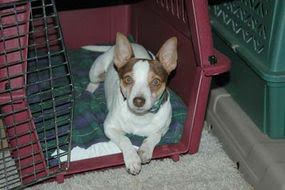Quck answer
Housebreaking your pet is a process of teaching them how to use the bathroom outside or in a designated area. It requires consistency, patience, and positive reinforcement. Start by establishing a routine for feeding and bathroom breaks. Use a command word or phrase to signal when it’s time to go outside. When accidents happen indoors, clean them up promptly and avoid scolding or punishment. Instead, reward your pet for going outside and making progress. Remember that every animal is different and may have their own pace of learning. With time and effort, you can successfully housebreak your pet and enjoy a clean and happy home.

Pets
Housebreaking your pet is an important aspect of animal training, particularly for indoor pets. It may seem like a daunting task, but it is a basic rule that every pet should learn. This article will discuss the elimination process of animals in the wild, why some animals are easier to housebreak than others, and popular methods for housebreaking pets (with a focus on dogs). Additionally, we will address common problems that trainers encounter during the process.
Everybody Poops
The elimination of waste is a natural process for all animals, and it serves several purposes beyond just getting rid of excess or unusable materials. For instance, animals may eliminate waste as a means of communication, protection or bonding. However, the timing and method of elimination can vary widely depending on the animal’s ecological niche. For example, herd animals like horses do not have bowel and bladder control because they spend their lives out in the open, where waste can be eliminated without any negative effects. On the other hand, animals that live in trees or fly overhead do not need bowel or bladder control because waste simply falls to the ground. Additionally, many mother animals will consume the waste products of their offspring to keep the bed area clean and minimize the risk of attracting predators.

Newborn kittens and puppies need stimulation from their mother’s tongue to eliminate until they are two to three weeks old. Many animals also use urine and feces to communicate with each other, as deposits of urine and feces can define an animal’s territory and serve as a warning to intruders. In summary, while housebreaking your pet may seem complicated, it is a fundamental aspect of animal training that can be successfully achieved through various methods.
If your pet is peeing all around the house, it may be due to their hormones telling them to mark their territory. Male animals are especially prone to marking or spraying to define and protect their domain. They may even mark where other animals have gone before. If your pet is lifting their leg or spraying on unfamiliar objects, it is a marking behavior. Female pets may also mark, but it’s more common in those that are not spayed or neutered.
Animals may also urinate as a sign of submission or when they are overexcited. If your pet is doing these things, it’s not a housebreaking issue, but an interspecies miscommunication. Ignoring the problem may make it go away, but scolding or yelling at your pet will only make it worse. If your dog wets the floor when you come home, try ignoring them until they have a chance to empty their bladder.
Neutering male pets at an early age may prevent marking behavior, but if it has already begun, neutering an adult pet can still reduce or eliminate the problem. A bellyband or doggy diaper may help keep things clean in the meantime.
The goal of housebreaking is to train your pet to go in a specific place. Some animals naturally prefer certain surfaces, while others must be trained. Praise your pet when they go in the right spot and prevent them from going in the wrong places. Housebreaking is about prevention rather than correction. You can also train your dog to eliminate on command using a specific phrase.
Dogs and cats feel safe in small, enclosed spaces, which is why they may hide under the porch or behind furniture. Most animals can be housebroken because they have a natural desire to be clean and won’t eliminate where they sleep, eat, or play. Use this to your advantage when housebreaking your pet.
When it comes to training a dog, the ultimate goal is usually to teach them to do their business outside. However, there are certain situations where this may not be possible, such as with very young or small dogs or for dogs that will always be indoors. In these cases, alternative methods can be used for potty training.
Crate Training
В
Crate training is an effective and simple way to housebreak dogs because it takes advantage of their natural instinct to den. Essentially, the crate becomes their indoor den or doghouse, and most dogs will not want to soil it. Using a crate can also prevent your dog from eliminating or destroying anything when you are not able to supervise them.
To crate train your dog, the first step is to choose a crate that is the appropriate size (see sidebar below for tips). Crates come in two types: the enclosed plastic airline crate and the collapsible wire crate. Which one you choose is up to personal preference. If you think you may want to fly with your dog, the enclosed plastic crate is the better option. If you choose a wire crate, you can drape a sheet or blanket over the back to make your dog feel more secure. Make sure to add some bedding or a blanket inside the crate to keep your dog comfortable.

В
It’s important not to use the crate for punishment because it should be your dog’s special space. To make your dog feel more comfortable in the crate, offer them a small treat whenever they go inside and feed them meals in it. Teach children that the crate is the dog’s safe space and they should respect their privacy while inside. Never put a dog wearing a choke chain or training collar in the crate as they could hurt themselves if it gets caught.
When introducing your dog to the crate, toss a treat inside and let them go in to get it with the door open. Once they are comfortable going inside, you can start closing the door for short periods before letting them out. Only let them out when they are quiet and behaved, as rewarding bad behavior will only make things worse. It may be difficult to ignore a crying puppy, but it’s better to endure it in the long run. Otherwise, you may inadvertently teach them that being loud will get them out of the crate.
Like humans, animals need to eliminate after waking up, after eating, and periodically throughout the day. When you let your dog out of the crate, take them straight to their designated potty spot and praise them when they go. Also, take them there after they eat, wake up, play, and every hour or so if they are running around.
In the next section, we will discuss two other methods of housebreaking: paper training and litter box training.

To begin crate training your dog, it’s important to first get them accustomed to the crate. However, it’s crucial not to misuse the crate. It’s best not to leave your dog crated for more than a couple of hours, as dogs need to stretch their legs. If you work long hours, consider hiring a dog sitter to come by and let your dog out for a potty break midday.
Puppies under six weeks old have underdeveloped digestive systems and should always have access to a space where they can eliminate. For puppies between two and eight months old, a good rule of thumb is to crate them for no longer than the number of hours they are months old. So, a three-month-old puppy can stay crated for three hours without soiling their crate. Any longer than that, and they may be physically unable to hold it. Asking them to do so is not only cruel but also counterproductive to your training efforts. A dog that is repeatedly forced to soil their bedding will be more challenging to housebreak in the end, as their natural desire to be clean erodes.
While the crate is primarily a housebreaking tool, a dog that is comfortable in a crate can enjoy other benefits. A crate-trained dog may be easier to travel with and more welcome in hotels. If you have guests who don’t like dogs, a crate can provide a safe place for your dog. It can also prevent fights during mealtime if you have multiple dogs.
When choosing a crate, it’s essential to pick one that is the right size. The crate should be just big enough for your dog to stand up, turn around, and lie down comfortably. If you have a small puppy that will grow into a large dog, you can borrow a crate from a friend or block off a portion of a larger crate with a cardboard box.
Paper and Litter Box Training

Paper training is a good way to train puppies where to eliminate indoors.
Photo courtesy Hannah Harris
Paper and Pads
One of the most significant advantages of paper training is a dog’s natural instinct to eliminate as far away from its living space as possible. To train your dog to eliminate in a particular area indoors, restrict them to a specific spot and place newspapers or puppy pads as far away from their food and bedding as possible. Alternatively, you can paper the entire area and gradually reduce the papered space as your puppy begins to identify the newspaper as the correct substrate.
Many manufacturers of puppy pads claim that their products have a special scent that can attract puppies to use them. You can achieve the same result by placing a paper towel or piece of newspaper with urine on top of the area where you want your puppy to eliminate. These scents signal to your dog that this area is suitable for elimination. Conversely, you should try to remove the scents of elimination as much as possible from areas where you do not want your dog to go. If your puppy has an accident, immediately clean the area with an enzyme-based cleaner. Avoid products that contain ammonia as the primary ingredient, as the smell can resemble that of urine.
Similar to training dogs to eliminate outside, take your puppy to the designated area after he eats, when he wakes up, and periodically throughout the day. Watch him carefully for signals that he needs to go, such as sniffing or circling, and take him to the designated area. Always praise him if he goes where he is supposed to.
Litter Box Training

Cats prefer substrates with a grainy or sandy texture so they can bury their waste.
Photo courtesy Amazon
Cats choose their location primarily based on the substrate. They are particular about this because they like to bury their waste. This gives cat owners a significant advantage over dog owners when it comes to housebreaking. All cat owners need to do is provide a bathroom area with a more appealing substrate than anything else and then teach the cat where to find it. Most cats prefer commercial litter over anything else, making most kittens “naturally” housebroken. Typically, housebreaking a cat involves teaching the cat where the litter box is, rather than how to use it.
When you bring a new cat or kitten home, confine them to a small space or room with their litter box. You can place your kitten in the litter box and gently make scratching motions with their paw if you wish, but usually, this step is not necessary. After a few days, if the cat is using the litter box, you can gradually increase the number of rooms they have access to, while still leaving them access to the litter box area.
A good rule of thumb is to provide one to two litter boxes per cat in a household. If you have a large house or multiple floors, you may need to provide multiple litter boxes.
When people have problems with housebreaking cats, it is typically due to not cleaning the litter box frequently enough or the cat has found a new substrate they prefer. Some cats like to use the dirt around plants, while others prefer carpet or plastic sheets. The easiest solution is to eliminate access to the problem areas. Sometimes, adding decorative stones to the base of a plant can resolve the issue. If eliminating the inappropriate area is not possible, try changing its context by placing food or bedding there.

To train a cat to use its litterbox, confining it in a small space with the box is sufficient.
Photo courtesy Hannah Harris
Teaching a dog to use a litterbox can be a difficult process. Although dog litter is available, dogs need to be trained to use it, as they have no natural inclination to bury their waste or seek out a litter-like surface. The manufacturers of doggy litter recommend keeping puppies in a large crate with bedding on one side and the litterbox on the other to encourage them to use the box. This method contradicts the basic principle of crate training, but the crate in this case serves as a very small room. Using a large open wire crate can help dogs feel more comfortable using the litterbox.
Next, we will discuss some common issues with housebreaking.
Handraising
When a puppy or kitten is handraised, simulating the mother’s tongue by gently cleaning the genital area with a warm damp washcloth allows the baby to relieve itself. If this is not done, it can result in serious consequences for the baby, who is otherwise unable to eliminate.
Physical and Behavioral and Housebreaking Problems

After a successful potty break, praise her while she’s still outside.
Photo courtesy Hannah Harris
If a dog that was previously housebroken starts having accidents, it is important to investigate for a physical cause. Bladder infections are common in female dogs, and kidney stones can cause straining and spotting in many male cats. Older pets may “leak” a little in their sleep, while diabetes can cause increased drinking and urination. If your pet is having accidents, it is important to visit the vet to rule out any physical problems. Most of these problems are treatable once they are diagnosed, but a few can be life-threatening if ignored.
If physical causes have been ruled out, communication issues may be at fault. Dogs need immediate feedback to make connections between actions and consequences. If you catch your dog eliminating in an inappropriate spot, firmly say “NO!” and take them to the designated area, praising them if they go there. However, if you come home to messes or your puppy goes while you are not paying attention, it is too late to do anything about it. Simply clean up and be more attentive next time.
Showcasing the mess to your pet does not effectively communicate what you want. Submissive behavior, not guilt or contrition, is what is being displayed when a pet cowers down and lowers their head. They are acknowledging that you are the boss and that you are upset, but they do not understand what they did wrong. For more information on effective dog training, see How Dog Training Works.
When a dog is sneaking off to eliminate in the house, there are two main reasons. Firstly, if the dog has been corrected for eliminating in front of you, it may believe that it is only not allowed to go in front of you and not that it should not eliminate in the house at all. Secondly, the dog may not recognize every part of the house as “den” and therefore off-limits for elimination. In both cases, the solution is to limit areas of the house where the dog cannot be supervised, take the dog outside regularly, and reward the dog with praise for eliminating in the right place.
Sometimes, dogs may have been trained to do something unintentionally. For example, giving a dog a treat when it comes inside after eliminating outside may result in the dog associating the treat with coming inside rather than eliminating outside. It is better to offer verbal praise while the dog is outside, or if you want to give a food reward, offer it while the dog is still outside.
Certain dogs, such as those from puppy mills, may be harder to housebreak due to a lack of natural inclination to stay clean. It is still possible to housebreak these dogs using the same techniques, but it may take longer. Similarly, small breed dogs may be more difficult to housebreak due to their size and tiny bladders. In such cases, restricting them to one room and training them to use pads or newspapers may be a kinder option when the owner is away for extended periods.
If an animal has the ability to be housebroken, the process can be simple; you just have to train them to prefer a particular area. Reward your pet for good behavior, limit accidents, correct mistakes immediately, and give them the opportunity to go in the appropriate place. The time it takes to train them depends on their size, age, and background, but consistency is the most important factor. A little extra effort at the beginning will be worth it in the long run!
For more information on housebreaking and related topics, follow the links on the next page.
Housebreaking Adult Dogs
Don’t dismiss the idea of adopting an adult dog due to housebreaking issues. Adult dogs have more control and can go longer without needing to use the bathroom. Additionally, many shelter dogs are accustomed to being outdoors, meaning they are likely already housebroken – if they have only ever gone outside, they may not think to go anywhere else!
Additional HowStuffWorks Articles
- How Dogs Work
- How Dog Training Works
- How Search-and-Rescue Dogs Work
- How Police Dogs Work
- How Guide Dogs Work
- How Underground Pet Fences Work
- Is Chocolate Poisonous to Dogs?
- How Does Catnip Work?
- Why Do Cats Have Whiskers?
- How Does a Cat’s Purring Work?
More Useful Links
- How to Successfully Housetrain Your Puppy
- The Basics of Housebreaking
- The Potty Wars
- Your New Cat and The Litterbox
- Cat Care: House Soiling
FAQ
1. What is housebreaking?
Housebreaking is the process of teaching your pet to eliminate waste outside or in a designated area indoors. This is an important step in the pet ownership process to ensure a clean and comfortable living environment for both you and your pet.
2. What age should I start housebreaking my pet?
It is recommended to start housebreaking your pet as early as possible, ideally between 12-16 weeks of age. This is when they have better bladder and bowel control and are more receptive to learning new behaviors.
3. What are the basic steps to housebreaking my pet?
The basic steps to housebreaking your pet include setting a consistent schedule for feeding, providing ample opportunities for outdoor breaks, using positive reinforcement, and monitoring your pet for signs of needing to eliminate.
4. How often should I take my pet outside during the housebreaking process?
It is recommended to take your pet outside every 1-2 hours during the housebreaking process, as well as after meals, naps, and playtime. This will help them develop a regular elimination routine and reduce the chances of accidents indoors.
5. What should I do if my pet has an accident indoors?
If your pet has an accident indoors, it is important to clean it up thoroughly to prevent lingering smells that may encourage future accidents. Avoid punishing your pet, as this can create fear and anxiety around elimination behaviors.
6. How long does the housebreaking process usually take?
The length of the housebreaking process can vary depending on your pet’s age, breed, and individual temperament. Some pets may learn quickly within a few weeks, while others may take several months to fully grasp the concept.
7. What are some common mistakes to avoid during the housebreaking process?
Common mistakes to avoid during the housebreaking process include inconsistent schedules, punishing your pet for accidents, not providing enough outdoor breaks, and not using positive reinforcement consistently.
8. Can I use indoor “potty pads” during the housebreaking process?
Using indoor potty pads can be a helpful tool during the housebreaking process, especially for puppies who may not have full control over their bladder and bowel movements. However, it is important to gradually transition your pet to outdoor elimination over time.
9. What are some signs that my pet needs to go outside?
Some common signs that your pet needs to go outside include sniffing around, circling a specific area, whining or scratching at the door, and suddenly becoming restless or agitated.
10. How can I reinforce good housebreaking behaviors?
You can reinforce good housebreaking behaviors by providing plenty of positive reinforcement, such as praise and treats, when your pet eliminates in the appropriate location. Consistency and patience are key to successfully housebreaking your pet.





Leave a Reply